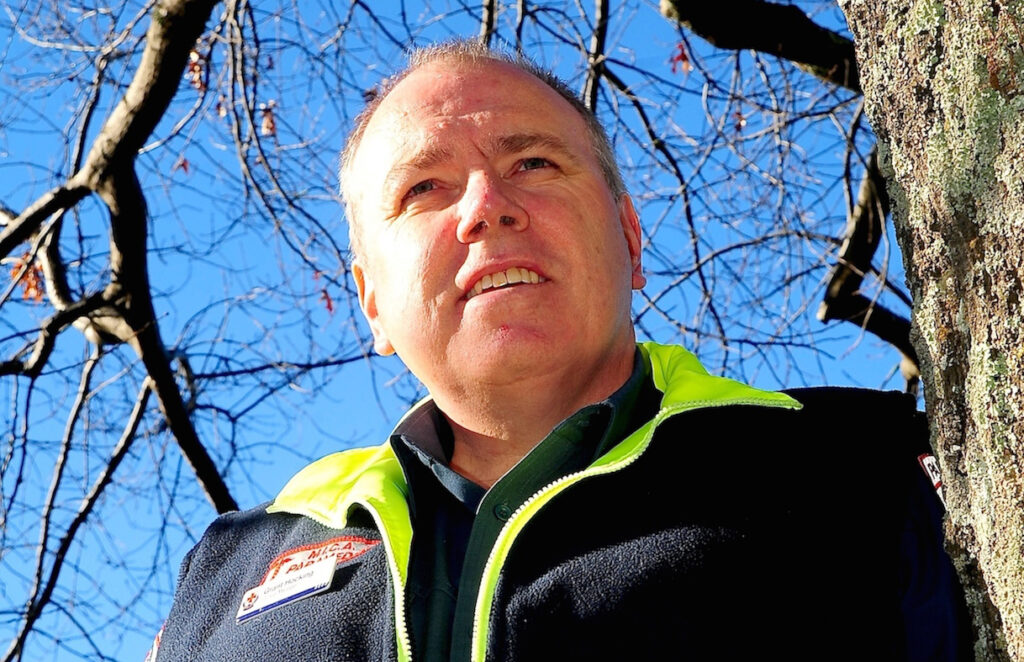Ambulance champion oversees telehealth trial
Grant Hocking has been with Ambulance Victoria for 36 years and has worked as a MICA paramedic, a clinical support officer and is currently the Improvement lead, covering statewide initiatives, with a focus on the Grampians.

Improving clinical quality is Grant’s great passion and he has an Ambulance Service Medal and a Stroke Foundation’s President’s Achievement Award, in recognition of his determination to improve pre-hospital care. Grant has changed internal Ambulance Victoria procedures and guidelines and directed statewide improvements in the treatment of stroke.
Grant, you’re involved in the development of stroke capable road ambulances which are being developed as part of Ambulance Victoria’s and the Stroke Alliance’s drive to reach more patients and to speed up care. How will they make a difference?
Later this year, we’re going to trial telehealth as a phone app in rural ambulances (which will be known as stroke capable road ambulances). Telehealth allows us to provide support to people regardless of their location in Victoria and it will assist in diagnosis of stroke, especially large vessel occlusions, using our ACT FAST protocol. The app will also connect paramedics to a neurologist in a similar way to the Victorian Stroke Telemedicine service.
The paramedics will be supported and offered advice by the neurologist on assessment and management, and where the patient should be transported to, especially if they need endovascular clot retrieval. Eventually, we hope to have the lightweight imaging devices onboard so a scan can be done in the field.
What a contrast to the way stroke was treated 36 years ago when you began.
Wow. If you go back even just 15 or 20 years, things were just so different. We didn’t have clinical practice guidelines at that stage. When a call came in, it wasn’t a code one so no lights or sirens, we weren’t asked to pre-notify hospitals that we were coming. The patient would be wheeled into a cubicle and left there until the scanner was available. And now we know that 1.9 million brain cells are dying every minute there is a blockage of oxygen and blood flow to the brain. Back then, the use of clot-busting medication was new and only three to seven per cent of Australians were receiving within the first four and a half hours. Most would be sent off to rehab for a few days, some didn’t even get physio or speech therapist, and many would simply go to a special care facility, severely disabled, or die.
These days, the mobile stroke ambulance is identifying patients with a clot or a bleed at the scene of the stroke. They’re thrombolysing 50 per cent of patients within 90 minutes of their stroke and 18 per cent within 60 minutes – that’s just absolutely remarkable.
As well, they’re transporting patients to the right location for endovascular clot retrieval 45 minutes faster than conventional pathways. Brilliant stuff.
A mobile stroke ambulance in Sydney will make a huge contribution to metro populations. We’ve come such a long way and Australian researchers are up there, with Europe, leading the world.
What are you excited about, as you work towards 2026 with the Stroke Alliance?
The lightweight scanners, 20 or 30 kilos in weight, in the back of ambulances and in fixed wing and rotary aircraft.
The dream is for us to be able to thrombolyse patients in the field, in rural and remote settings. It’s fundamentally an issue of equity and access. I’ve been around a long time and I know it is a step by step process and there are a lot of partners going full steam to make it happen. I really want to get this done and I am here for the long haul. It’s going to be incredible.